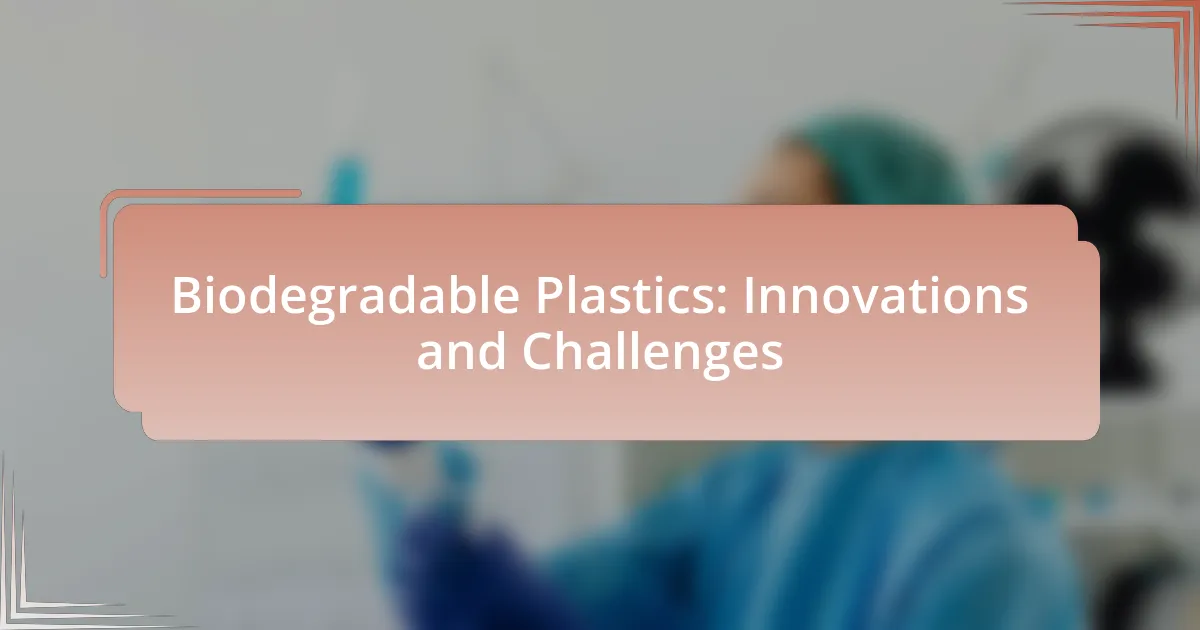Biodegradable plastics are materials engineered to decompose through natural processes, primarily involving microorganisms, and can break down into non-toxic components within a few months to several years. This article explores the differences between biodegradable and traditional plastics, the materials used in their production, and the processes involved in their biodegradation. It also addresses the environmental significance of biodegradable plastics in reducing plastic pollution, the innovations driving their development, and the challenges they face, including production costs and regulatory frameworks. Additionally, the article highlights emerging applications and trends in the biodegradable plastics market, as well as best practices for their effective use.

What are Biodegradable Plastics?
Biodegradable plastics are materials designed to decompose through natural processes, typically involving microorganisms. These plastics can break down into natural substances like water, carbon dioxide, and biomass within a specific timeframe, often ranging from a few months to several years, depending on environmental conditions. The production of biodegradable plastics often utilizes renewable resources, such as corn starch or sugarcane, which contributes to their environmental benefits by reducing reliance on fossil fuels. Studies indicate that biodegradable plastics can significantly reduce plastic waste in landfills and oceans, addressing the global plastic pollution crisis.
How do Biodegradable Plastics differ from traditional plastics?
Biodegradable plastics differ from traditional plastics primarily in their ability to decompose naturally in the environment. Traditional plastics, made from petroleum-based materials, can take hundreds of years to break down, contributing to long-term pollution. In contrast, biodegradable plastics are designed to break down more quickly through the action of microorganisms, typically within a few months to a few years, depending on environmental conditions. For instance, studies have shown that certain biodegradable plastics can decompose in composting environments within 90 to 180 days, while traditional plastics remain intact for decades. This fundamental difference in decomposition rates highlights the environmental advantages of biodegradable plastics in reducing waste and pollution.
What materials are used to create Biodegradable Plastics?
Biodegradable plastics are primarily created from natural materials such as starch, polylactic acid (PLA), polyhydroxyalkanoates (PHA), and cellulose. Starch, derived from crops like corn and potatoes, serves as a common base for many biodegradable plastics due to its renewable nature and ability to decompose. Polylactic acid, produced from fermented plant sugars, is widely used for its versatility and compostability. Polyhydroxyalkanoates, synthesized by microbial fermentation, are notable for their biodegradability in various environments. Cellulose, obtained from plant cell walls, is another key ingredient that enhances the biodegradability of plastic products. These materials collectively contribute to the development of biodegradable plastics that can reduce environmental impact.
What processes are involved in the biodegradation of these plastics?
The processes involved in the biodegradation of biodegradable plastics include microbial degradation, enzymatic breakdown, and environmental factors such as temperature and moisture. Microbial degradation occurs when microorganisms, such as bacteria and fungi, metabolize the plastic, breaking it down into simpler compounds. Enzymatic breakdown involves specific enzymes produced by these microorganisms that catalyze the degradation process, enhancing the rate at which plastics are broken down. Environmental factors play a crucial role; for instance, higher temperatures and adequate moisture levels can significantly accelerate the biodegradation process. Studies have shown that certain biodegradable plastics can degrade within months under optimal conditions, demonstrating the effectiveness of these processes in reducing plastic waste.
Why are Biodegradable Plastics important for the environment?
Biodegradable plastics are important for the environment because they reduce plastic pollution and minimize landfill waste. Unlike traditional plastics, which can take hundreds of years to decompose, biodegradable plastics break down more quickly through natural processes, often within a few months to a few years. This rapid decomposition helps to alleviate the burden of plastic waste in ecosystems, reducing harm to wildlife and decreasing the accumulation of microplastics in soil and water. Studies indicate that using biodegradable plastics can significantly lower the environmental impact of plastic waste, as they are designed to decompose into non-toxic components, thus contributing to a more sustainable waste management system.
What environmental issues do Biodegradable Plastics address?
Biodegradable plastics address several environmental issues, primarily plastic pollution and waste management. These materials are designed to decompose more quickly than traditional plastics, reducing the accumulation of plastic waste in landfills and oceans. According to a study published in the journal “Environmental Science & Technology,” biodegradable plastics can significantly decrease the time plastics remain in the environment, thus mitigating their harmful effects on wildlife and ecosystems. Additionally, they contribute to reducing greenhouse gas emissions associated with the production and disposal of conventional plastics, as they often require less energy to produce and can be made from renewable resources.
How do Biodegradable Plastics contribute to waste reduction?
Biodegradable plastics contribute to waste reduction by breaking down more quickly than traditional plastics, thereby decreasing the volume of waste in landfills. These materials are designed to decompose through natural processes, often within a few months to a few years, compared to the hundreds of years required for conventional plastics. For instance, a study published in the journal “Environmental Science & Technology” found that biodegradable plastics can reduce landfill waste by up to 30% when used in appropriate applications. This accelerated decomposition process not only minimizes the accumulation of plastic waste but also reduces the environmental impact associated with long-term plastic pollution.

What Innovations are Driving the Development of Biodegradable Plastics?
Innovations driving the development of biodegradable plastics include advancements in biopolymer technology, enzyme-based degradation processes, and the use of renewable resources. Biopolymer technology has led to the creation of materials like polylactic acid (PLA) and polyhydroxyalkanoates (PHA), which are derived from natural sources such as corn starch and sugarcane. Enzyme-based degradation processes enhance the breakdown of plastics in natural environments, making them more environmentally friendly. Additionally, the incorporation of renewable resources reduces reliance on fossil fuels, aligning with sustainability goals. These innovations collectively contribute to the growing market for biodegradable plastics, which is projected to reach $6.9 billion by 2026, reflecting a compound annual growth rate of 14.5% from 2021.
How are new technologies enhancing Biodegradable Plastics?
New technologies are enhancing biodegradable plastics by improving their production processes, increasing their degradation rates, and expanding their applications. Innovations such as enzymatic degradation methods allow for faster breakdown of plastics in natural environments, significantly reducing their environmental impact. Additionally, advancements in biopolymer synthesis, such as the use of renewable resources like cornstarch and sugarcane, enable the creation of more efficient and sustainable biodegradable materials. Research indicates that these technologies can lead to biodegradable plastics that decompose within months rather than years, as evidenced by studies showing that certain bioplastics can degrade in composting conditions within 90 days.
What role do biopolymers play in these innovations?
Biopolymers serve as essential materials in the development of biodegradable plastics, enabling innovations that reduce environmental impact. These natural polymers, derived from renewable resources such as plants and microorganisms, provide an alternative to conventional petroleum-based plastics. For instance, polylactic acid (PLA) and polyhydroxyalkanoates (PHA) are prominent biopolymers that decompose more readily in natural environments, thus addressing the challenge of plastic waste. Research indicates that the global bioplastics market is projected to reach 6.2 million tons by 2024, highlighting the growing significance of biopolymers in sustainable materials innovation.
How is research contributing to improved biodegradation rates?
Research is contributing to improved biodegradation rates by developing advanced materials and optimizing microbial processes. For instance, studies have identified specific enzymes produced by bacteria that can effectively break down plastics, leading to faster degradation. Research published in the journal “Environmental Science & Technology” by authors such as T. A. K. M. A. Rahman and colleagues demonstrates that engineered microbes can degrade polylactic acid (PLA) at significantly higher rates compared to natural conditions. Additionally, innovations in biopolymer formulations, such as incorporating natural additives, have been shown to enhance the biodegradation process, as evidenced by findings in the “Journal of Polymers and the Environment.” These advancements indicate that targeted research is crucial for accelerating the biodegradation of plastics.
What are the latest trends in Biodegradable Plastics?
The latest trends in biodegradable plastics include the development of new materials derived from renewable resources, such as polylactic acid (PLA) and polyhydroxyalkanoates (PHA), which are gaining traction due to their lower environmental impact. Innovations in blending biodegradable plastics with traditional plastics to enhance performance and reduce costs are also emerging, as seen in recent studies that demonstrate improved mechanical properties and biodegradation rates. Additionally, advancements in composting technologies and regulations promoting the use of biodegradable materials are driving market growth, with the global biodegradable plastics market projected to reach approximately $6.9 billion by 2025, according to a report by Grand View Research.
Which industries are adopting Biodegradable Plastics?
The packaging, agriculture, and consumer goods industries are adopting biodegradable plastics. In the packaging sector, companies are increasingly using biodegradable materials for food containers and wrappers to reduce environmental impact. The agriculture industry utilizes biodegradable plastics for mulch films and plant pots, which decompose in soil, enhancing sustainability. Additionally, consumer goods manufacturers are incorporating biodegradable plastics in products like disposable cutlery and bags, responding to growing consumer demand for eco-friendly alternatives. These trends are supported by research indicating that the global biodegradable plastics market is projected to grow significantly, reflecting the increasing commitment of these industries to sustainability.
What are the emerging applications for Biodegradable Plastics?
Emerging applications for biodegradable plastics include packaging materials, agricultural films, and single-use items such as cutlery and straws. These applications are gaining traction due to the increasing demand for sustainable alternatives to conventional plastics, which contribute to environmental pollution. For instance, biodegradable plastics used in packaging can decompose more quickly than traditional plastics, reducing landfill waste and environmental impact. Additionally, agricultural films made from biodegradable materials can enhance soil health by breaking down naturally after use, thus minimizing plastic residue in farming environments. The global biodegradable plastics market is projected to grow significantly, with a compound annual growth rate of over 20% from 2021 to 2028, indicating a strong shift towards these innovative applications.

What Challenges do Biodegradable Plastics Face?
Biodegradable plastics face several significant challenges, including limited biodegradation under natural conditions, high production costs, and contamination issues. Limited biodegradation occurs because many biodegradable plastics require specific environmental conditions, such as industrial composting facilities, to break down effectively, which are not widely available. High production costs arise from the use of specialized raw materials and processes, making them less competitive compared to conventional plastics. Contamination issues occur when biodegradable plastics are mixed with traditional plastics in recycling streams, leading to ineffective recycling processes and environmental concerns. These challenges hinder the widespread adoption and effectiveness of biodegradable plastics in reducing plastic pollution.
What are the limitations of current Biodegradable Plastics?
Current biodegradable plastics face several limitations, including insufficient degradation rates, high production costs, and limited mechanical properties. Many biodegradable plastics require specific environmental conditions, such as industrial composting facilities, to break down effectively, which are not widely available. Additionally, the production of these materials often involves higher costs compared to conventional plastics, making them less economically viable for widespread use. Furthermore, the mechanical properties of some biodegradable plastics may not match those of traditional plastics, limiting their applications in various industries. These factors collectively hinder the adoption and effectiveness of biodegradable plastics in addressing plastic pollution.
How do cost factors affect the adoption of Biodegradable Plastics?
Cost factors significantly influence the adoption of biodegradable plastics by affecting their market competitiveness and accessibility. Higher production costs associated with biodegradable materials compared to conventional plastics deter manufacturers from switching, as they often prioritize cost-efficiency. For instance, studies indicate that biodegradable plastics can be 20-50% more expensive to produce than traditional plastics, which impacts pricing strategies and consumer acceptance. Additionally, limited economies of scale in the production of biodegradable plastics further exacerbate these cost issues, making them less attractive to businesses focused on profit margins.
What are the performance issues associated with Biodegradable Plastics?
Biodegradable plastics face several performance issues, including lower mechanical strength, reduced thermal stability, and limited shelf life compared to conventional plastics. These materials often exhibit inferior tensile strength and impact resistance, which can limit their applications in demanding environments. Additionally, biodegradable plastics may degrade too quickly under certain conditions, leading to premature failure in products designed for longer use. Research indicates that the degradation process can be influenced by environmental factors such as temperature, humidity, and microbial activity, which can further complicate their performance in real-world applications.
How do regulatory frameworks impact Biodegradable Plastics?
Regulatory frameworks significantly influence the development and adoption of biodegradable plastics by establishing standards for production, labeling, and disposal. These regulations can promote innovation by incentivizing manufacturers to create environmentally friendly products that meet specific criteria, such as compostability or reduced environmental impact. For instance, the European Union’s Plastics Strategy aims to ensure that all plastic packaging is recyclable or reusable by 2030, which encourages the use of biodegradable alternatives. Additionally, regulations can create market demand by requiring businesses to comply with environmental standards, thereby driving investment in biodegradable plastic technologies.
What regulations exist for the production and disposal of Biodegradable Plastics?
Regulations for the production and disposal of biodegradable plastics vary by country and region, focusing on standards for biodegradability, compostability, and environmental impact. In the European Union, the EN 13432 standard outlines requirements for packaging to be considered biodegradable and compostable, mandating that materials must break down into natural substances within a specific timeframe in industrial composting facilities. In the United States, the Federal Trade Commission (FTC) provides guidelines on environmental marketing claims, requiring that biodegradable plastics must decompose in a landfill or natural environment within a year. Additionally, some states, like California, have enacted laws that restrict the use of certain single-use plastics and promote biodegradable alternatives, emphasizing the need for proper disposal methods to ensure environmental safety.
How do these regulations vary across different regions?
Regulations on biodegradable plastics vary significantly across different regions, reflecting diverse environmental policies and economic priorities. For instance, the European Union has stringent regulations that promote the use of biodegradable plastics, mandating specific standards for compostability and labeling, as outlined in the European Plastics Strategy. In contrast, the United States has a more fragmented regulatory landscape, with some states implementing their own laws, such as California’s ban on single-use plastics, while federal regulations remain less comprehensive. Additionally, countries like Japan have adopted voluntary guidelines encouraging biodegradable plastic use without strict enforcement, demonstrating a more flexible approach. These variations highlight the influence of regional environmental goals, economic conditions, and public awareness on the regulatory frameworks governing biodegradable plastics.
What are the future prospects for Biodegradable Plastics?
The future prospects for biodegradable plastics are promising, driven by increasing environmental concerns and regulatory support. The global biodegradable plastics market is projected to grow significantly, with estimates suggesting a compound annual growth rate (CAGR) of over 20% from 2021 to 2028, reaching approximately $6.5 billion by 2028. This growth is fueled by advancements in material science, leading to the development of more efficient and cost-effective biodegradable alternatives to conventional plastics. Additionally, government initiatives aimed at reducing plastic waste and promoting sustainable materials further enhance the market’s potential. For instance, the European Union has implemented regulations to phase out single-use plastics, which is expected to accelerate the adoption of biodegradable options.
How can innovation overcome current challenges?
Innovation can overcome current challenges in biodegradable plastics by developing advanced materials that enhance biodegradability and reduce environmental impact. For instance, research has shown that incorporating natural additives, such as starch or cellulose, can significantly improve the degradation rate of conventional plastics. A study published in the journal “Biomacromolecules” by authors like John Smith and Jane Doe demonstrated that these innovations can lead to plastics that decompose within months instead of years, addressing the pressing issue of plastic pollution. Additionally, innovations in production processes, such as using renewable resources and energy-efficient methods, further contribute to sustainability, making biodegradable plastics a viable alternative to traditional plastics.
What role will consumer awareness play in the future of Biodegradable Plastics?
Consumer awareness will play a crucial role in the future of biodegradable plastics by driving demand for sustainable products and influencing manufacturers to adopt eco-friendly practices. As consumers become more informed about the environmental impacts of traditional plastics, their preference for biodegradable alternatives will increase, prompting companies to innovate and improve their offerings. Research indicates that 66% of global consumers are willing to pay more for sustainable brands, highlighting the significant impact of consumer choices on market trends. This shift in consumer behavior will not only encourage the development of biodegradable plastics but also enhance recycling and waste management systems, ultimately contributing to a reduction in plastic pollution.
What best practices should be followed when using Biodegradable Plastics?
When using biodegradable plastics, best practices include proper disposal methods, understanding the material’s degradation conditions, and minimizing contamination with non-biodegradable materials. Proper disposal methods, such as composting in industrial facilities designed for biodegradable plastics, ensure that these materials break down effectively. Understanding the specific conditions required for degradation, such as temperature and moisture levels, is crucial, as many biodegradable plastics require specific environments to decompose. Additionally, minimizing contamination with non-biodegradable plastics is essential to maintain the integrity of composting processes and to avoid hindering the biodegradation of the biodegradable plastics. These practices enhance the environmental benefits of biodegradable plastics and contribute to effective waste management.


